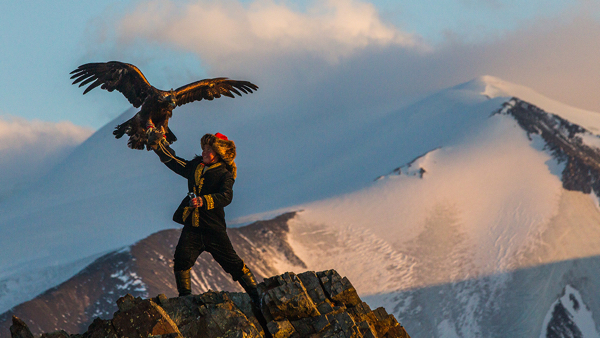Movie review by Greg Carlson
A completely engaging adventure on each of its multiple levels, Otto Bell’s “The Eagle Huntress” combines old-fashioned nature documentary with both a rousing sports competition angle and a front-and-center challenge to gender role expectations that translate universally beyond the remote Mongolian setting. Aisholpan Nurgaiv, a 13-year-old Kazakh girl, is instantly likable: a no-nonsense kid who earns top marks at her boarding school and can pin any and all of the boys at wrestling. Aisholpan intends to become a doctor, but in the meantime, she devotes herself to the male-only province of hunting game with golden eagles.
Aisholpan’s father Nurgaiv Rys is the latest in a twelve-generation line of eagle hunters, and Bell opens the movie with a stunning sequence in which the viewer learns the rudiments of traditional Central Asian falconry. Birds are collected directly from the nest during a brief window of flightless days just prior to full fledging (a later set-piece grippingly demonstrates this endeavor). According to the information presented in the film, a “bird lord” becomes the custodian of an eagle for a period limited to seven years. Once the raptor’s service concludes, the hunter returns the animal to the wild.
Aided by Simon Niblett’s nimble photography, which includes drone footage, human and animal-mounted cameras, and gorgeous wide shots that share the massive scale of the Altai mountain range, “The Eagle Huntress” showcases a unique father-daughter relationship en route to Aisholpan’s participation in the annual Golden Eagle Festival. Editing to heighten the suspense surrounding Aisholpan’s chances as a first-time contestant and the inaugural female participant, Bell and Pierre Takal adroitly include portrait interviews with a series of skeptical elders dismayed by the change represented by Aisholpan.
In part because of the support Aisholpan receives from her parents and her grandfather, some critics have argued that “The Eagle Huntress” lacks a certain kind of interpersonal conflict or drama. In his original Sundance review for “The Hollywood Reporter,” Boyd van Hoeij goes farther, calling into question the film’s nonfiction bona fides, citing his “nagging suspicion throughout that there’s been more preparation for especially the set-pieces than would normally be the case on a documentary.” Considering the breadth of methodologies and styles in the evolution of the nonfiction film, Van Hoeij’s critique of the participatory aspects of Bell’s craft misses the target.
For cinephiles and documentary fans, the behind-the-scenes story of “The Eagle Huntress” is as thrilling as Aisholpan’s own journey. Director Bell saw breathtaking photographs of eagle hunters captured by Asher Svidensky in 2014, and the sight of Aisholpan – who was likely the only female apprentice of the skill on the entire planet – sparked him into action. Jason Guerrasio’s “Business Insider” story lays out the rest of the broad strokes: Bell exhausting his entire life savings along with another 12K loan; an appeal to Morgan Spurlock to come on board as an executive producer so Bell could complete shooting; recruiting Daisy Ridley as another executive producer and the movie’s narrator, and Sia for an original song.
Even without Ridley and Sia, who underscore the movie’s central theme of how 21st century gender expectations can be challenged anywhere, “The Eagle Huntress” makes for rousing entertainment in which no computer-generated effects of any kind are needed to communicate something awe-inspiring and, for young people growing up in the United States, otherworldly. During the screening I attended, my own seven-year-old daughter turned to me and asked, “Is this real?”
